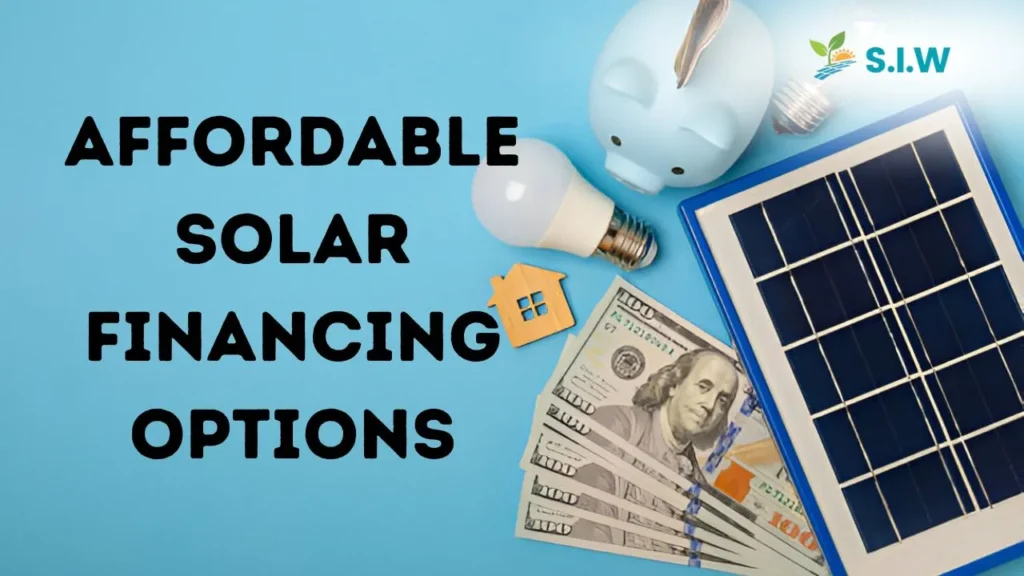As the demand for renewable energy grows, more homeowners and businesses are turning to solar power. However, the upfront cost can be a barrier. Fortunately, various affordable solar financing options exist to help you overcome this hurdle. In this article, we will explore the best solar financing strategies to help you make an informed decision. Let’s dive into the details.
What is Solar Financing?
Solar financing refers to various methods that allow homeowners and businesses to pay for the installation of solar power systems without covering the entire cost upfront. With several options available, you can spread the payments over time, enabling you to benefit from clean energy while maintaining financial flexibility.
Why Financing Solar is Important
With the rising cost of traditional energy sources and the need to transition to renewable energy, solar power has become an attractive solution for reducing both energy bills and carbon footprints. However, the initial cost of solar installations can be steep. Financing makes it possible for more people to access solar energy without a significant upfront investment.
Top Affordable Solar Financing Options
1. Solar Loans
Solar loans are a common financing option where you borrow the money needed to purchase and install a solar system, and then repay it over time with interest.
Types of Solar Loans:
- Secured Loans: These loans require collateral, often your home, and typically offer lower interest rates. They can be ideal if you’re confident in your ability to repay the loan.
- Unsecured Loans: With no collateral required, unsecured loans are more accessible but usually come with higher interest rates.
Benefits:
- Full ownership of the solar system.
- You qualify for tax credits and incentives.
- Flexible loan terms ranging from 5 to 20 years.
2. Power Purchase Agreements (PPAs)
In a Power Purchase Agreement, a solar company installs solar panels on your property at no upfront cost. Instead of purchasing the system, you agree to buy the electricity it produces at a reduced rate.
Benefits:
- No upfront costs.
- Lower energy bills with predictable rates.
- Maintenance and repairs are handled by the provider.
Drawbacks:
- You don’t own the solar system, so you won’t qualify for tax credits or other financial incentives.
- Potentially longer contract terms (up to 25 years).
3. Solar Leases
A solar lease works similarly to a PPA, but instead of paying for the energy the system generates, you pay a fixed monthly lease fee. The leasing company owns and maintains the system, and you enjoy the benefits of solar energy.
Benefits:
- Little to no upfront costs.
- Fixed monthly payments.
- No responsibility for maintenance.
Drawbacks:
- You don’t own the system and cannot claim tax incentives.
- Lease terms can be long, typically around 20 years.
4. Home Equity Loans
Home equity loans or lines of credit allow you to borrow against the equity in your home to finance your solar installation.
Benefits:
- Low-interest rates, often tax-deductible.
- Long-term repayment options.
Drawbacks:
- Your home is used as collateral, so failure to repay can put your property at risk.
5. PACE Financing (Property Assessed Clean Energy)
PACE financing is a government-backed program that allows homeowners to finance solar panels through their property tax bill. The loan is repaid over time via an assessment on the property.
Benefits:
- No upfront costs.
- Eligibility isn’t based on credit score.
- Transferable to the new property owner if you sell your home.
Drawbacks:
- Repayment is tied to your property taxes, which can increase your annual tax bill.
- Limited availability based on location.
Key Factors to Consider When Choosing Solar Financing
1. Upfront Costs
Evaluate whether you’re comfortable with paying upfront or would prefer to finance the entire system. Some financing options, such as PPAs or leases, require no initial payment.
2. Ownership and Incentives
Owning the system outright, whether through cash purchase or a loan, qualifies you for federal and state tax incentives, which can significantly reduce the overall cost of your solar investment.
3. Monthly Payments
Determine your budget and select a financing plan with manageable monthly payments. Solar loans offer predictable payments, while PPAs or leases may fluctuate depending on the energy produced.
4. Maintenance and Repairs
If you prefer to avoid maintenance responsibilities, a solar lease or PPA might be ideal since the provider handles repairs and upkeep. With a loan, you are responsible for the system’s maintenance.
5. Length of Financing Terms
Consider how long you want to be paying for your solar system. Loan terms vary widely, with some offering as short as five years, while leases and PPAs may lock you into contracts for up to 25 years.
Federal and State Incentives for Solar Financing
Solar energy is supported by numerous government incentives designed to reduce the cost of installation. Some key programs include:
1. Federal Solar Investment Tax Credit (ITC)
The ITC allows you to deduct 26% of the cost of installing a solar energy system from your federal taxes. This incentive is available to both homeowners and businesses.
2. State-Specific Rebates and Incentives
Many states offer additional rebates, tax credits, or performance-based incentives to encourage solar adoption. Check your state’s specific programs to maximize your savings.
3. Net Metering
Net metering allows you to sell excess energy generated by your solar system back to the grid. This can offset your electricity bills and reduce your overall energy costs.
Pros and Cons of Financing Solar Energy

Choosing the right solar financing option depends on your financial situation, long-term energy goals, and preference for ownership. Whether you prefer a loan, lease, or PPA, financing makes solar energy accessible and affordable for nearly everyone. By understanding the various options and incentives, you can confidently transition to renewable energy while keeping your budget in check.








